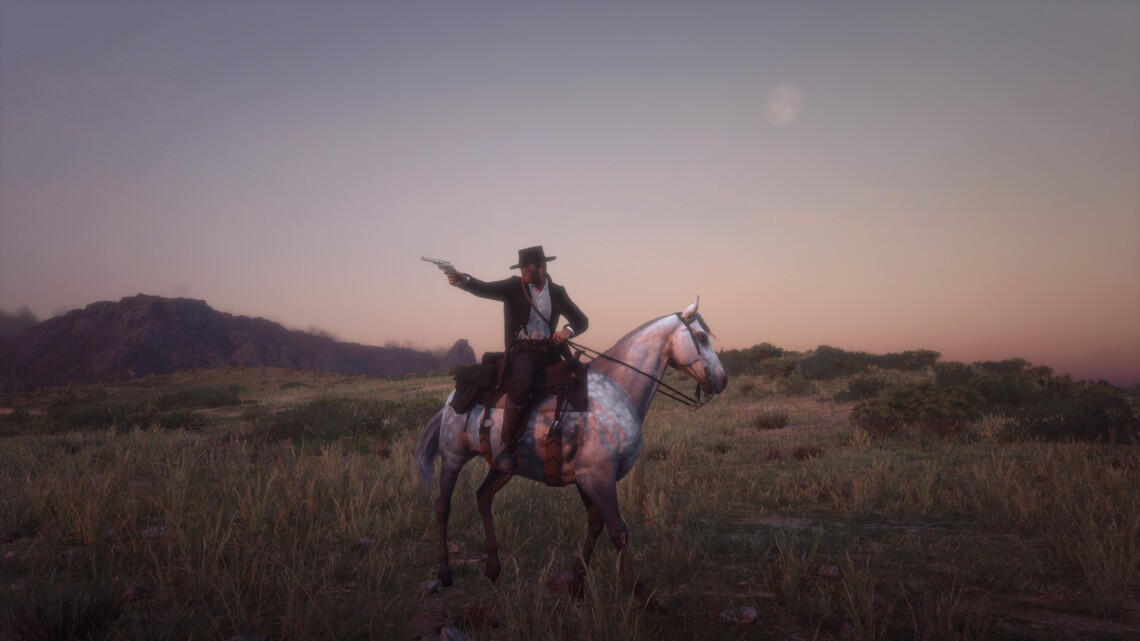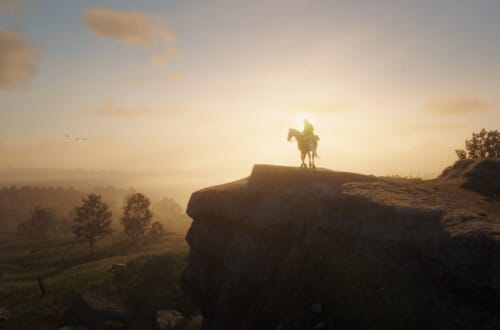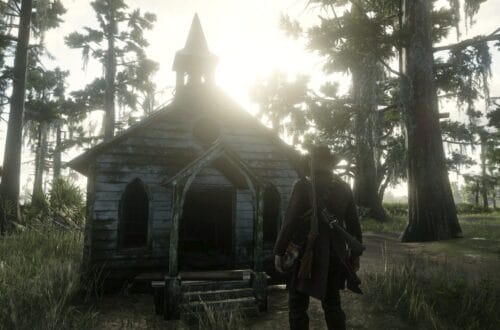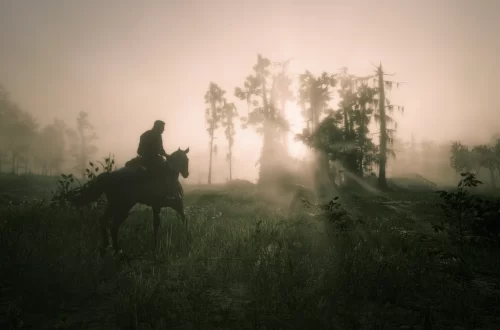An introduction to the ways Arthurian legend shapes the themes and narrative of Red Dead Redemption 2.
All articles on this site feature detailed discussion of literary allusions in Red Dead Redemption 2, and as such contain unmarked major and minor spoilers for the game. This piece also contains spoilers for Red Dead Redemption. Read at your own risk.
TW: Fictional deaths of children.
It wouldn’t be much of an exaggeration to say that everyone in the English-speaking world, and much of the rest of the world besides, has heard of King Arthur and the Knights of the Round Table. But this statement is more vexed than it first appears. Which version of King Arthur have people heard of, and which versions of the knights? The stories have been told and retold over centuries and across countries, characters swapped into and out of roles, split and merged, even their biological relationships changed. Red Dead Redemption 2 writers tended to rely on the older medieval sources to create their project, but at the time those tales were being penned, writers borrowed heavily from one another, which can make it difficult to identify which exact texts RDR2 uses. For instance, the most famous of the old Arthurian texts is Sir Thomas Malory’s Le Morte Darthur, which combines and retells many other sources. It’s one of several works that writers used to create RDR2, but probably not the most important.
Although Arthurian legend covers the entirety of the king’s life, Red Dead Redemption 2 only concerns itself with two periods. The most important of these, in terms of the game’s plot, is the fall of Arthur’s court. RDR2 uses many Arthurian sources, but one of the most important is the Mort le Roi Artu, or The Death of King Arthur, by an unknown author. In this story, the best knight of the Round Table, Lancelot, is discovered to be having an affair with Guinevere, King Arthur’s wife. Enraged, Arthur orders her put to death. Lancelot saves her, but when he rescues her from the knights guarding her, he unwittingly kills one of his dearest friends, Gaheriet (Gareth, in most English sources). War ensues. Eventually, impressed by Lancelot’s chivalry, Arthur becomes reluctant to continue fighting, but Gaheriet’s brother Gawain goads him on incessantly. While Arthur is away fighting, Mordred, who he’s left in charge of his lands, stages a coup. Mordred is secretly Arthur’s own son, fathered with Morgan le Fay (at the time Arthur slept with her, he didn’t know she was his sister; none the less, his downfall is sometimes portrayed as the punishment for this unwitting sin). A mortally wounded Gawain repents of his quest for vengeance and urges Arthur to call for Lancelot’s aid, but Arthur (incorrectly) thinks Lancelot wouldn’t help him. In a final battle, Arthur and Mordred kill each other, and nearly every great knight dies.
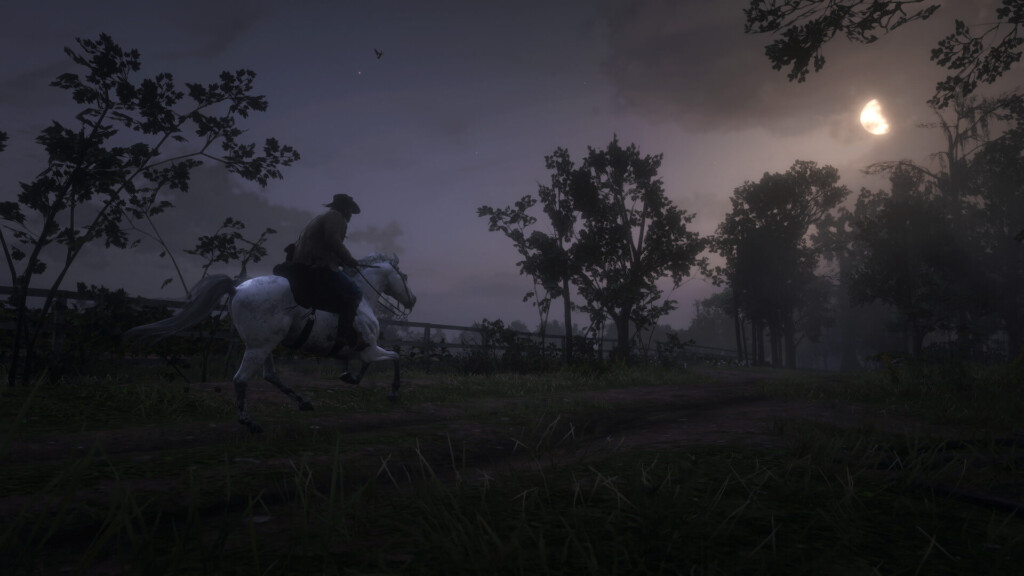
What’s in a Name?
The first thing to note about RDR2’s use of Arthurian legend is that the names are deceptive. The names of minor characters hint at this: Sir Gareth is one of the best and purest of the knights; Gareth Braithwaite is one of Catherine’s indistinguishable and cloddish sons. Sir Tarquin is a wicked and malevolent knight (Malory 105-106); Tarquin Trelawny is Josiah’s young son. These are hints to look at the Arthurian names in RDR2 slantwise. Usually, in RDR2, allusive names are attached to characters in a meaningful way. In the case of Arthurian legend, they’re far more broad. Their primary purpose is to put the player in mind of story of King Arthur, not necessarily to state specific parallels.
Arthur Morgan’s name is an allusion to King Arthur and his sister, Morgan le Fay. Morgan is a wicked sorceress; King Arthur is an exemplary knight. The name “Arthur Morgan,” therefore, is representative of the duality the narrative claims belongs to that character. Despite how obvious this allusion is — Sean MacGuire even calls Arthur “King Arthur” in camp — it’s misleading. By rights, Dutch Van der Linde should be called Arthur Morgan, but obviously, he already had a name from the first game. He’s the (ersatz) king who trusts the wrong people, listens to the wrong people, and fights the wrong people. In his anger over Arthur Morgan’s supposed disloyalty, Dutch is actually more like Guinevere, who believes rumors that Lancelot — someone totally loyal to her — has fallen in love with another woman. She becomes bitterly, hatefully jealous towards him, just as Dutch comes to sneeringly distrust Arthur, who is fatally loyal. But it’s King Arthur to whom Dutch is most similar. In one revealing instance of camp dialog, Uncle (Dutch’s double) says of him, “That’s his problem, in one. He wants to be an American king … with his knights.” Like Satan, Dutch’s secret desire to rule himself overcomes his stated desire for freedom from rule. Eventually, he helps to kill one of his “sons” — Micah, who represents the scheming, dishonorable Mordred. This very event leads to his being killed, in a manner of speaking, by another of his “sons,” just as King Arthur kills and is killed by his son. Dutch is also partly to blame for his “son” Arthur’s death.
One of the earliest sources to mention Arthur, the chronicle History of the Britons by Nennius, says that Arthur killed his son, Amr (although we are given no explanation for this)(Lupack 15). Arthur, in an atypically dishonorable act, even attempts to avoid the fate his adviser Merlin predicts by putting all the babies in his lands born on May Day into an unmanned ship and casting it to sea, killing all the babies but Mordred (Malory 31). The king, usually portrayed as a paragon of courtesy and knightly honor, has somehow always been tied to the theme of filicide.
Although the parallel is even more subtle in Arthur Morgan’s case, it’s in this that he is perhaps most like King Arthur. He blames himself for his son Isaac’s death, and the game tends to agree with him1: the newspaper article “Family Murdered” says that a boy named Isaac was killed by highway robbers. At Clawson’s Rest, two young boys have died because their mother left to confront men who stole from her and never came home. Criminals like Arthur are to blame for the deaths of little boys. Isaac’s death “hardened” Arthur (“Archeology for Beginners”), and this hardness helped Arthur ignore his real feelings and collect debts for Strauss (see entry after “Money Lending and Other Sins III,” for instance), leading to his own death. He neither killed nor was killed by his son, but the deaths are linked nonetheless.
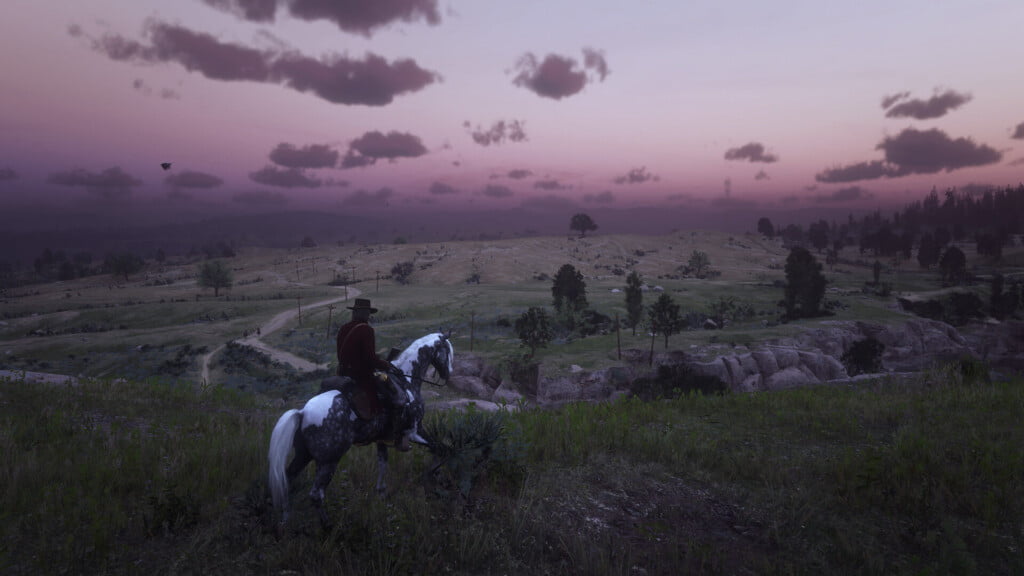
Far more than King Arthur, Arthur Morgan resembles Lancelot (as well as two other characters, to be discussed soon). As James Cable notes in his translation, “The principal character, and the one whose psychology is drawn in greatest depth, is Lancelot. The whole of The Death of King Arthur is in fact a sort of spiritual and psychological biography of Lancelot. In the book, Lancelot gradually climbs from the depths of sin to what is practically a form of sainthood at the end” (13). This is the same type of journey RDR2 portrays, if in a secular sense. Lancelot is the greatest of Arthur’s knights; Arthur is the best of Dutch’s men — and both become mistrusted despite it. The parallels are many: One of the reasons King Arthur suspects Lancelot is that Morgan le Fay hosts him in a room where she previously had Lancelot imprisoned, and he painted and wrote scenes from his life on the walls, just as Arthur Morgan writes and draws in his journal (70). At the end of “That’s Murfree Country,” Dutch nearly kills Molly over her false confession of disloyalty, just as King Arthur nearly kills Guinevere over her actual disloyalty, and Arthur stops him, just as Lancelot saves Guinevere from her execution. King Arthur says that Lancelot is “the best knight among us” (Malory 469); Dutch describes Arthur as “the best man amongst us” in camp dialog (one of very few instances of a near-direct quotation from another work). Lancelot frequently fights on King Arthur’s behalf, just as Arthur does for Dutch. Perhaps this is the most vital parallel: Lancelot’s devotion to King Arthur and Arthur’s to Dutch.
Arthurian Legend Shapes the Themes of RDR2
It’s in Arthur Morgan, as it is in Lancelot, that we see the themes of their respective works most clearly portrayed. Arthur desperately wants to believe in Dutch, but he also wants to live according to his own best principles. Most of the Beaver Hollow chapter explores the tensions between those conflicting desires. Lancelot strives to be the ideal knight, which involves following a variety of codes and conventions, but
Of course, he fails to be perfect in all these areas—partly because they place conflicting demands on him. By being a true lover to Guinevere, he fails in the quest for the Grail and he is less than loyal to his king. But the attempt to adhere to the conflicting codes is what gives Lancelot his grandeur; and the very fact of those conflicts is what makes him the sort of character with whom readers for centuries have been able to identify, even as they recognize his failings—or perhaps because they recognize his failings—in the great enterprise he has undertaken.
Alan Lupack 135
While removing the cheating wife from RDR2’s allegory of King Arthur’s fall was wise — even necessary — given that Rockstar has nurtured misogyny in its player base, it saps some of the electricity generated by the friction between the codes of courtly love, spiritual duty, and chivalry. All the same, we see the opposing forces in Arthur’s mind as he struggles to reconcile his love for the man who raised him with the fact that he’s concerned for the lives of other people — that he’s “worried about folk,” as he says (“Favored Sons”). One passage from The Death of King Arthur could easily describe Arthur Morgan’s own thoughts:
When Lancelot saw how the castle was besieged by King Arthur, the man he had most loved in the world and whom he now knew to be his mortal enemy, he was so saddened that he did not know what to do, not because he feared for himself but because he loved the king.
135
Arthur spends much of the main story’s final act similarly unsure what to do, for the same reason.
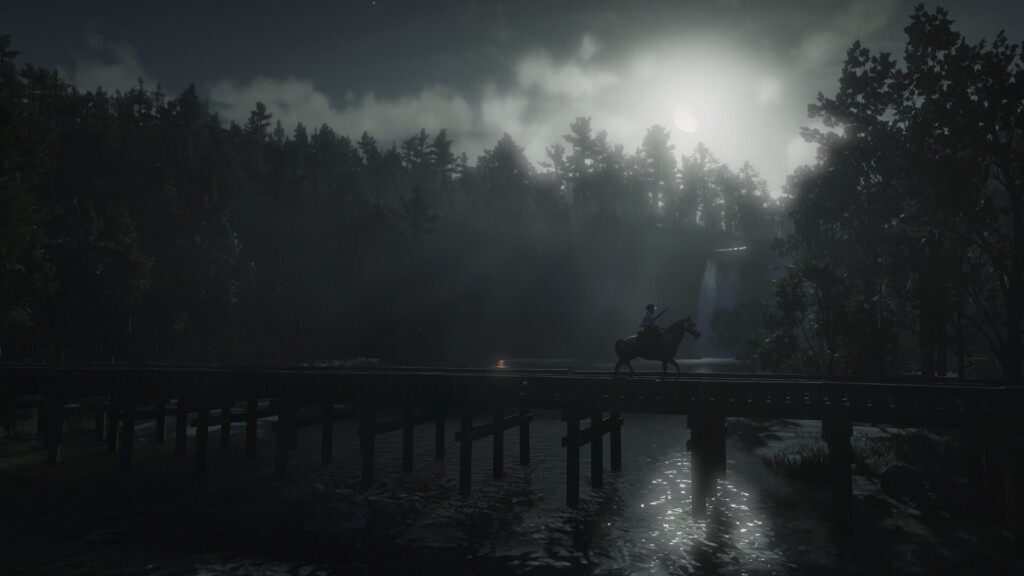
It’s tensions such as these that lead to the fall of Arthur’s court and Dutch’s Boys. The court fails to follow their principles of fellowship and brotherhood (Malory xiii). Dutch’s Boys fail to follow those same principles, as well as their principles of helping people in need. As Alan Lupack says, “The Arthurian world, like the modern world, has great potential for improving the human condition; but it seems that such an ideal is always frustrated by the failings and imperfections that are inherent in the world and in those who inhabit it” (147). This statement equally applies to Dutch and the gang. In both Arthurian legend and Red Dead Redemption 2, characters’ failures to live up to their own lofty ideals destroys utterly the worlds they’ve built. These losses are mourned as catastrophic tragedies. In Arthurian legend, it’s sometimes promised that King Arthur will return one day — but the game doesn’t take that tone. It’s brutally unhopeful, aligning with those writers who say that Arthur is gone for good. Like Eden, what is lost can never be recovered, only dreamt of.
New here? Visit the Table of Contents to read the essays in order, or the Index & TL;DR to explore the site by topic. New essays are published Wednesdays at 1 p.m. E.T./10 a.m. P.T. Sharing the site is always appreciated!
- According to Roger Clark, the actor who played Arthur, originally, “Arthur had a newborn who froze to death on the way through Colter” (“Red Dead Redemption II Cast [SacAnime Summer 2019]”). In that scenario, the child’s death is a direct consequence of Arthur’s lifestyle. Of course, since this was cut, it can’t be regarded as real evidence in interpreting the text, but it is indicative of the writers’ attitudes. ↩︎
Bibliography
Expand to view sources.
- Anonymous. The Death of King Arthur. Translated by James Cable. Penguin Books, 1971.
- Houser, Dan, et al. “Red Dead Redemption II.” Rockstar Games, 2018.
- Lupack, Alan. Oxford Guide to Arthurian Literature and Legend. Oxford University Press, 2005.
- Malory, Sir Thomas. Le Morte Darthur. Edited by Helen Cooper. Oxford University Press, 1998.
- “Red Dead Redemption II Cast [SacAnime Summer 2019].” YouTube, uploaded by Convention Coverage, 27 Jul. 2019, https://www.youtube.com/watch?v=ifohZGPVBMQ.
